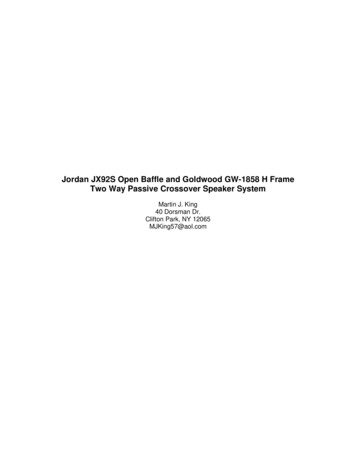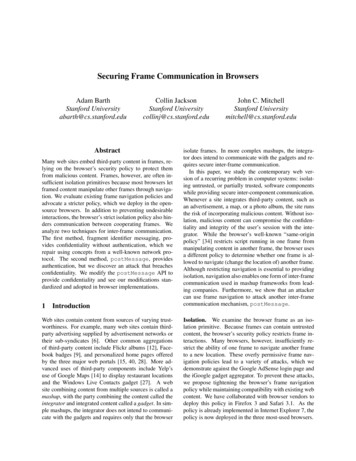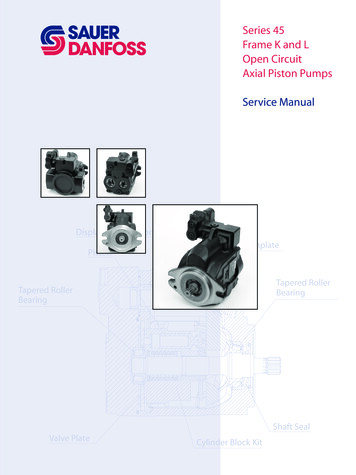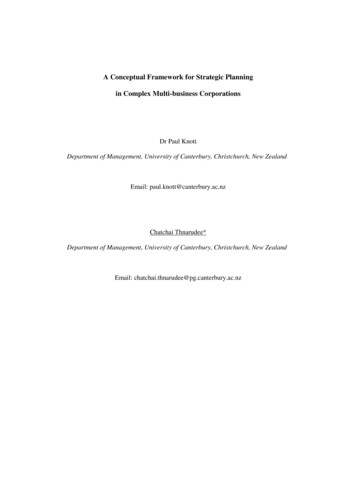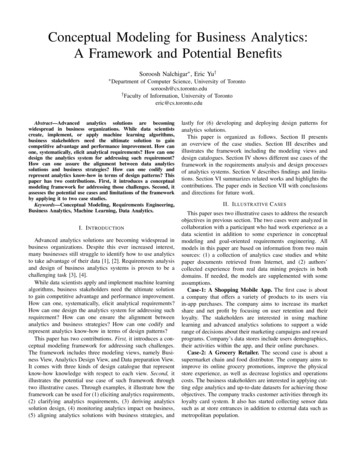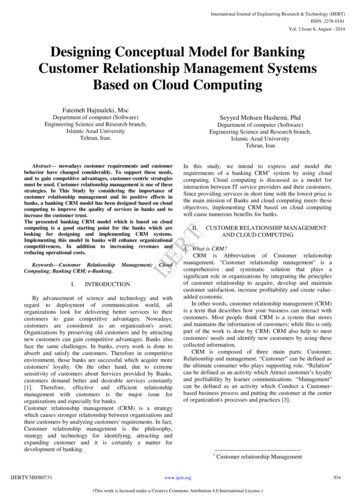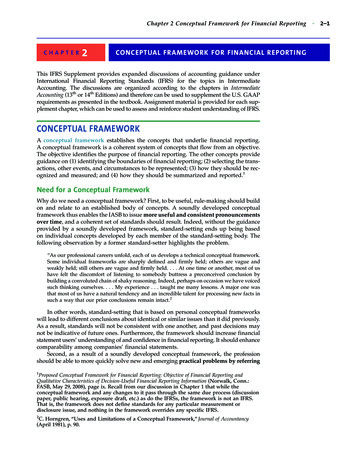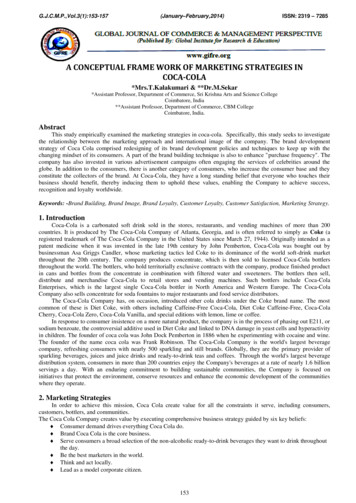
Transcription
4)ISSN: 2319 – 7285A CONCEPTUAL FRAME WORK OF MARKETING STRATEGIES INCOCA-COLA*Mrs.T.Kalakumari & **Dr.M.Sekar*Assistant Professor, Department of Commerce, Sri Krishna Arts and Science CollegeCoimbatore, India**Assistant Professor, Department of Commerce, CBM CollegeCoimbatore, India.AbstractThis study empirically examined the marketing strategies in coca-cola. Specifically, this study seeks to investigatethe relationship between the marketing approach and international image of the company. The brand developmentstrategy of Coca Cola comprised redesigning of its brand development policies and techniques to keep up with thechanging mindset of its consumers. A part of the brand building technique is also to enhance "purchase frequency". Thecompany has also invested in various advertisement campaigns often engaging the services of celebrities around theglobe. In addition to the consumers, there is another category of consumers, who increase the consumer base and theyconstitute the collectors of the brand. At Coca-Cola, they have a long standing belief that everyone who touches theirbusiness should benefit, thereby inducing them to uphold these values, enabling the Company to achieve success,recognition and loyalty worldwide.Keywords: -Brand Building, Brand Image, Brand Loyalty, Customer Loyalty, Customer Satisfaction, Marketing Strategy.1. IntroductionCoca-Cola is a carbonated soft drink sold in the stores, restaurants, and vending machines of more than 200countries. It is produced by The Coca-Cola Company of Atlanta, Georgia, and is often referred to simply as Coke (aregistered trademark of The Coca-Cola Company in the United States since March 27, 1944). Originally intended as apatent medicine when it was invented in the late 19th century by John Pemberton, Coca-Cola was bought out bybusinessman Asa Griggs Candler, whose marketing tactics led Coke to its dominance of the world soft-drink marketthroughout the 20th century. The company produces concentrate, which is then sold to licensed Coca-Cola bottlersthroughout the world. The bottlers, who hold territorially exclusive contracts with the company, produce finished productin cans and bottles from the concentrate in combination with filtered water and sweeteners. The bottlers then sell,distribute and merchandise Coca-Cola to retail stores and vending machines. Such bottlers include Coca-ColaEnterprises, which is the largest single Coca-Cola bottler in North America and Western Europe. The Coca-ColaCompany also sells concentrate for soda fountains to major restaurants and food service distributors.The Coca-Cola Company has, on occasion, introduced other cola drinks under the Coke brand name. The mostcommon of these is Diet Coke, with others including Caffeine-Free Coca-Cola, Diet Coke Caffeine-Free, Coca-ColaCherry, Coca-Cola Zero, Coca-Cola Vanilla, and special editions with lemon, lime or coffee.In response to consumer insistence on a more natural product, the company is in the process of phasing out E211, orsodium benzoate, the controversial additive used in Diet Coke and linked to DNA damage in yeast cells and hyperactivityin children. The founder of coca cola was John Dock Pemberton in 1886 when he experimenting with cocaine and wine.The founder of the name coca cola was Frank Robinson. The Coca-Cola Company is the world's largest beveragecompany, refreshing consumers with nearly 500 sparkling and still brands. Globally, they are the primary provider ofsparkling beverages, juices and juice drinks and ready-to-drink teas and coffees. Through the world's largest beveragedistribution system, consumers in more than 200 countries enjoy the Company's beverages at a rate of nearly 1.6 billionservings a day. With an enduring commitment to building sustainable communities, the Company is focused oninitiatives that protect the environment, conserve resources and enhance the economic development of the communitieswhere they operate.2. Marketing StrategiesIn order to achieve this mission, Coca Cola create value for all the constraints it serve, including consumers,customers, bottlers, and communities.The Coca Cola Company creates value by executing comprehensive business strategy guided by six key beliefs: Consumer demand drives everything Coca Cola do. Brand Coca Cola is the core business. Serve consumers a broad selection of the non-alcoholic ready-to-drink beverages they want to drink throughoutthe day. Be the best marketers in the world. Think and act locally. Lead as a model corporate citizen.153
4)ISSN: 2319 – 72851. Strategic planning:In past years, the company had a great success, as the strategy worked which resulted in making Coca ColaCompany the world's leading company.Company accomplished the crust of its strategy as, Worldwide volume increased by 4 percent with strong international growth of 5 percent. Earnings per share grew by 82 percent. Return on common equity grew from 23 percent to 38 percent this year. Return on capital increased from 16 percent in 2000 to 27 percent. The company has generated free cash flow of 3.1 billion, up from 2.8 billion.The marketing strategy for the future is as follows: Accelerate carbonated soft-drink growth, led by Coca-Cola. Selectively broaden the family of beverage brands to drive profitable growth. Grow system profitability and capability together with our bottling partners. Serve customers with creativity and consistency to generate growth across all channels. Direct investments to highest potential areas across markets. Drive efficiency and cost-effectiveness everywhere.2. Strategies of qualityAfter Micro and macro analysis Brand "coke" is primarily role1. Enhance competition moments2. When people watch cricket3. Through commercialization4. Fun time3. Expanding target marketIn last 2 years Coke has come back in aggressive manner. Consumer has choice Attractive brand name Brand differentiatingConsumer Has Got Choice:Now the consumer has got choice. Because now they know the name of another big brand, though coke is the 2ndbest name but it can get a better position after some timeAttractive Brand Name:Now the consumers know the Name of Coke, because Coke is the name, which is the most popular after the word"ok". So people can better differentiate brands with each other.Brand Differentiation:Now different companies have got different brand names. So, people can distinguish between brands. Two majorbrands "coke" and "Pepsi" also have brand names.4. Strategies of getting goals:To increase the price is the least thing, which Coke can adopt. There are so many ways through which Coke canincrease the profits. Some major ways are as follows. Volume can be increased Interest level of consumers To take part in energetic festivals5. Marketing strategy:What people want in a beverage is a reflection of who they are, where they live, how they work and play, and howthey relax and recharge. Whether you're a student in the United States enjoying a refreshing Coca-Cola, a woman in Italytaking a tea break, a child in Peru asking for a juice drink, or a couple in Pakistan buying bottled water after a runtogether, we're there for you. We are determined not only to make great drinks, but also to contribute to communitiesaround the world through our commitments to education, health, wellness, and diversity. Coke strives to be a goodneighbor, consistently shaping our business decisions to improve the quality of life in the communities in which we dobusiness.6. Price strategy:Trade Promotion:Coca cola company gives incentives to middle men or retailers in way a that they offer them free samples and freeempty bottles, by this these retailers and middle man push their product in the market following "Seen as sold"Different Price in Different Seasons:Sometimes Coca Cola Company changes their product prices according to the season. Summer is supposed to be agood season for beverage industry in Pakistan.So in winter they reduce their prices to maintain their sales and profit.7. Promotion strategies:Getting shelves:They get or purchase shelves in big departmental stores and display their products in those shelves in attractivestyle.Eye Catching Position:Salesman of the coca cola company positions their freezers and their products in eye-catching positions. Normallythey keep their freezers near the entrance of the stores.154
4)ISSN: 2319 – 7285Sale Promotion:Company also do sponsorships with different college and school's cafes and sponsors their sports events and otherextra curriculum activities for getting market share.Development Strategy of Coca Cola:Brand development strategy of Coca Cola has been far reaching and has managed to remain in the limelight eversince it became a favorite with the non alcoholic drinkers. It has been noticed that brand loyalty is an important factor inmaintaining the number one position. The article below suggests the various brand building techniques of the company.Founded in the year 1886, the Coca Cola company enjoys the status of being one of the biggest non alcoholicbeverage companies of the world. It has a distribution system, which makes it unique from the rest of the non alcoholicbeverage manufacturers. Over the years, Coca Cola has passed several tests of brand enhancement and the companymakes it a point that the products under the banner Coca Cola continue to invade the minds of the consumers.The brand development strategy of Coca Cola comprised redesigning of its brand development policies andtechniques to keep up with the changing mindset of its consumers. Earlier, this brand believed in the following: Afford ability Availability AcceptabilityHowever, this brand development strategy of Coca Cola was re worked to stress on the following instead: Price value Preference "Pervasive penetration".The essence of brand building of the company lies in the fact that it wants its consumers accessibility to be "withinan arm's reach of desire". In an attempt to build its brand identity, as many as 20 brand attributes are tested every monthinvolving as many as 4000 customers. The brand development strategy of Coca Cola is effective as it has been able toconstruct, manage as well as maintain its brand image since yesteryears.Another reason why this brand has gained unanimous acceptance all around the globe is due to the fact that it hasbeen able to connect very well with its consumers. This implies brand loyalty. Brand loyalty has been instrumental inkeeping up the brand image of Coca Cola. It believes in shelling out the best so that the consumers are retained bydefault. A part of the brand building technique is also to enhance "purchase frequency". The company has also investedin various advertisement campaigns often engaging the services of celebrities around the globe. In addition to theconsumers, there is another category of consumers, who increase the consumer base and they constitute the collectors ofthe brand. The collectors usually indulge in collecting old as well as upcoming logos of Coca Cola, bottles and literarymatter. With regard to the brand development of Coca Cola Zero, the company came out with an advertisement, whichwas quite different from the conventional ones. In this regard, (no calorie beverage), it has shelled out three types ofproducts. Coca Cola Classic Diet Coke Coca Cola Zero.There are few experts who believe that when Coca Cola had the tag line of "The Real Thing", it was really that butwith the invention of various categories of coke, the "real thing" changes to "many things", and the original flavor isusually lost. Hence, the brand building strategies should be such that it does not confuse people and is able to retainconsumers despite the fact that several new non alcoholic beverage firms are on the anvil.3. Marketing ApproachBoth the Coca-Cola and Pepsi try to market as part of a life-style. Coca-Cola uses phrases such as "Coke side oflife", while Pepsi uses phrases such as "Hot stuff", to promote the ideathat Pepsi is "in sync" with the cool side of life. Pepsi tries to reach outto the younger generation by appealing to pop culture. Coca-Cola's isless flashy and uses a classical appeal, most likely because of CocaCola's long history as the standard for cola beverages.The operation review according to the segments is as follows:So the volume is least in the Africa and most in the North America.The data about the market share of this company area wise is given inthe following table.The above table shows the geographical earning of the CocaCola Company and from this data; we can find out that the customersof Coca Cola are increasing which is shown by the company’s percapita income. Unit case equals 24 eight-ounce servings. The column,which shows the non-alcoholic beverages consist of commercially,sold beverages, as estimated by the Company based on availableindustry sources. The country column is derived from the Company'sunit case volume while the industry column includes nonalcoholicready-to-drink beverages only, as estimated by the Company based onavailable industry sources.In Asian population, which is the satisfied customer of Coca Cola, is approximately 3.2 billion and the averageconsumer enjoys close to two servings of our products each month. Through an intense focus on Coca-Cola, innovationand new beverages, the company has achieved volume growth of 10 percent in 2002. With developing economies and155
4)ISSN: 2319 – 7285populations, this region has strong long-term potential, and the company is building an exciting family of beveragebrands in addition to expanding the popularity of our core brands, led by Coca-Cola. In China, for example, sales ofCoca-Cola increased 6 percent.Fig.1 Coca cola’s international revenue4. International image of the companyThe founder of
The brand development strategy of Coca Cola is effective as it has been able to construct, manage as well as maintain its brand image since yesteryears. Another reason why this brand has gained unanimous acceptance all around the globe is due to the fact that it has
